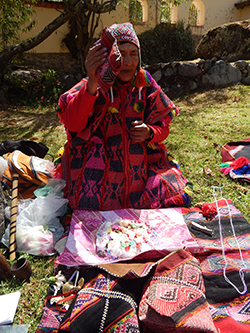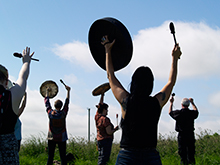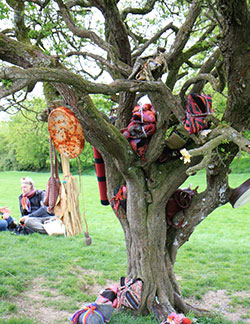What is shamanism?

Shamanism is the oldest spiritual practice and healing modality in the world – existing in every culture and co-existing with all religions and political systems. While the term has varied across cultures, along with the many ways of practicing it, shamanism has endured through changing times with timeless similarities.
The shaman is, above all, awake to the ever-changing world, both seen and unseen – in-touch with the invisible energies affecting the physical world. Journeying into altered states of greater awareness, the shamanic practitioner gains access to invisible energies, partnering with spirits to change hidden dissonances into visible healing. Whether called to do shamanic work or choosing the calling, the shaman learns to use his or her natural healing power to bring balance between both worlds.
Every culture has had its own traditional name for Spirit, energy, life-force or sacred power. From the mana of the New Zealand Maori and other Pacific cultures to the wakan spoken by the Sioux, every cultural group has uttered its special word for that source which connects all things, yet remains elusive in translation. For the shaman, spirit is ultimately translated through direct experience. By working intimately with creative forces of the universe, the shaman comes to know those powers, moving and redirecting energies into more life-affirming paths. Through continual discernment, the shaman is able to perceive intents behind energy, to determine whether they are malevolent or benevolent, and finally root out destructive fears at their source. Through consciousness-raising rituals of song, dance and intention, the shaman labors like an artisan to master the ever-changing elements at his fingertips. The process is ever-unique according to the talents, training, temperament and life experience of the practitioner.
The Shamanic Universe

The shaman has been compared to a type of priest, but in shamanism there is no revelatory book, no strict doctrine or single belief system. Unlike formal religion, shamanism depends upon direct experience vs. faith to dictate its methods. The map for navigating the terrain might change according to cultural origin or circumstance, but the underlying cosmology is universal in meanings and characteristics. Through altered states of consciousness, the shaman enters a deeper reality where there is no separation between physical and spiritual – where humanity and God are deeply connected. Through the wakeful eyes of a practicing shaman, acts of healing and divining meaning are natural outflows of life. In the hands of a capable shaman, an individual regains balance, harmony and integrity of their life force.
The art of shamanism is naturally built into the DNA of every person, regardless of race, sex or orientation. Whether traditional or modern forms of shamanism, the practitioner is in the business of restoring harmony to the individual and to any relationship with family, ancestors, society or the environment. No human issue lies outside the realm of the shaman who adapts to meet the current “spirit” of the age – whether helping protect the village crops or guiding an executive through a challenging career. The shaman works side-by-side with the community, helping to heal in practical ways.
The Art of Journeying

Shamans journey through altered states of consciousness into sacred invisible realms. But what distinguishes shamanic practice from other spiritual disciplines is the practitioner’s ability to act with conscious intention – in partnership with spirits. Through training and initiation, the shaman develops close working relationships with spirits. Guided by spirits or energy, the shaman diagnoses energetic sources of problems, and then crafts solutions to balance or heal those problems in the physical world. Prescriptions can range from the actions the shaman takes in the invisible world to instructing an individual about remedies – ranging from herbs to Western medicine or from making changes in behavior to making offerings and sacrifices.
Every shamanic journey is unique and spontaneous. Through training, skill, and natural ability, the practitioner masters the art of moving between spiritual and physical worlds. The most powerful and effective shamans are those who have trained their natural abilities.
Rituals and techniques for entering altered states of consciousness vary by culture, geography, individual needs, and practitioner skills. Common tools like drums, song, rattling, and dancing are fundamental and instrumental in connecting with the spirit world. Shamans are often depicted in states of ecstasy while in communication with spirit, in an experience of connection to all things. But ecstasy is not the purpose of the journey. Nor is the power of the ritual about what the shaman appears to be doing in the physical world. What matters is the practical acts of healing occurring in the invisible realm.

Universal Shamanic Characteristics
Every shamanic tradition has a different metaphoric map or reference points for traveling the spirit world, based upon inherited mythologies and symbologies. Whether an image of a World Tree as envisioned by the Sami of Lapland, or a Mountain imagined by the Qero of the Andes, shamans rely on guideposts for navigating between the material and spiritual worlds. But as anthropologists continue to point out, the essential features of shamanic journeying are strikingly more alike than different across cultures – beyond what can be explained by cross-cultural dissemination. Anthropologist, Mircea Eliade has cited five classically defining characteristics of shamans from all corners of the world:
- Shamans experience altered states, transporting them beyond the physical and allowing them to interact with a myriad of spirits. The shaman travels to the Upperworld to work with spirits of a Celestial realm and Supreme Being. The Sami of Lapland describe metaphorically climbing to the Upperworld on the branches of the world tree, while the Qero of the Andes conjure the image of climbing up the mountain from the center of the world.
- Through altered states, the shaman also travels to the Lowerworld to work with animals, earth and other spirits – described in oral traditions as climbing down the roots of the tree of life or swimming down in a spirit boat from the base of the mountain.
- Shamans experience relationships with helping spirits who guide, protect and empower the shaman.
- Shamans collaborate closely with ancestors, holding respect for their wisdom and guidance.
- Through experience and close relationships with spirits, shamans comprehend the immaterial soul or conscious energy in all things.
The Ritual of Altered States
Depending on the needs of the individual, shamans traditionally enter altered states to either leave the body or to be embodied by spirit. In the state of journeying or “soul-flight,” the shaman leaves his or her body to retrieve information, power, or parts of the soul in the spiritual realm. Journeying is also the path for psychopomp or escorting deceased souls to the land of the dead. In states of “embodiment,” the shaman invokes a helping spirit into his or her body for the purpose of bringing back energy to the spirit world – by cleansing, extraction (returning intrusive energies) or divination. Energies needing removed can range from the simplest kinds of blockages all the way to very complex spirit forms to be exorcised – with densities of every form and emotion in between. The experienced shaman can move between states of journeying and embodiment in necessary degrees to meet the individual’s needs, working in partnership with spirits – and in harmony with the mysterious flows of the universe.
Though every shamanic ritual is unique, each one follows a basic protocol. The shaman first clarifies an intention and creates a sacred space through prayers, offerings or blessings. Upon preparation, the shaman invokes the necessary altered state of consciousness for diagnosing, prescribing and healing. Once finished with healing or divination work, the shaman returns to normal consciousness, closes the ritual space, and dictates any other prescriptions to the individual.
The Work of Traditional Shamanism
Traditional forms of shamanism have been deeply rooted in community, with the mission of helping to maintain harmony between people with the spirit world, animal world, and environment. With the needs of the community and of individuals continually changing, a practitioner would be available day or night with healing rituals often lasting indefinite periods of time. The living turned to the shaman for psychopomp, ensuring souls of the dead returned to the spirit world without lingering troubles. Hunters depended upon the shaman to negotiate with animals for hunting magic. The whole community would seek the shaman to restore balance to any individual who disrupted the group harmony.
Among individuals, the shaman was sought for all types of retrieval ritual – from gaining guidance and good fortune to bringing back lost or stolen soul parts. Sick and troubled people experienced relief through cleansing or extraction rituals for sending dissonant energies back to the spirit world. The shaman, concerned with all of life, lived in service of the common good.
From Traditional to Core Shamanism
Local community needs have changed over time as global economies expand. But the need to survive remains. People still seek help from shamans for the practical problems of everyday living. Shamans still heal individuals and community through extraordinary means by working consciously in the spirit world. But life challenges have evolved. Hunting has given way to career concerns, while shamanic rituals evolve to support those radically different needs. The function of the shaman remains the same, but the ritual form accommodates a different world of landscapes and mythologies, which involve different problems, and unique spirits along with them.
In the wake of lost and changing traditions, many present-day practitioners embrace an amalgam of many various shamanic traditions. The modern creation of Core Shamanism or Neo-shamanism within the last 30 years, attributed to anthropologist Michael Harner, retains the crucial elements of ancient forms. Just as always, the modern shaman enters into altered states, consciously partnering with spirits in the invisible world – acting to heal and balance disharmonies in people, communities and environments. More than ever, the shaman works wide-awake in the knowledge that the ever-changing magical nature of the living universe never changes.
Shamanic training courses at Green Tara College
 The starting point for all our shamanic training is the Foundation in Shamanism
The starting point for all our shamanic training is the Foundation in Shamanism
https://www.greentara.ie/zoom-shamanism/
The program is as follows:
- Foundation in Shamanism – this provides the basic skills. Details are below. This course is 2 hours per week, every Tuesday. [more details]
- Intermediate Shamanism – this is a 6-month course, 2 hours per week, every Thursday. Intermediate Shamanic training assumes certain key shamanic skills, taught in the Foundation in Shamanism course. However, if you already have those, you can enter this course directly, or take Foundation in Shamanism at the same time. The main focus is building your psychic power and a number of empowering initiations from the Q’ero tradition (Peru). [more details]
- Shamanic Practitioner – This is a 1-year course, with an optional second year for advanced work. This course assumes the skills developed in the previous classes and will focus on working with clients. We do not think someone can do this safely without the skills and training from the previous courses, though people can acquire those skills elsewhere – we are not requiring they have attended our classes, only that they are ready for the heavy-duty work of healing others. [more details]

